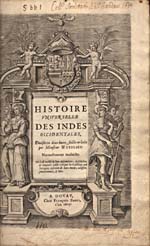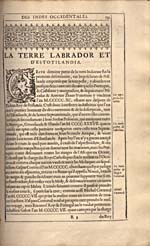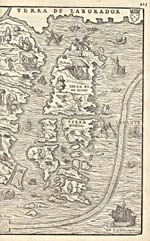|
|
THE CORTE REAL BROTHERSGaspar Corte Real (c. 1450 - c. 1501)
|
 |
 |
|
| Title page of Wytfliet's account of the Corte Reals' voyages Copyright/Source |
Page from Wytfliet's account of the Corte Reals' voyages Copyright/Source |
|
"[…] les Portugais ayants descouvert toutes les rivages de l'Afrique en Orient, Colomb par la charge des Roys Catholiques feit le mesme en l'occident, & comme chaque nation vouloit avoir les Moluques en sa possession; Gaspar Cortereal l'an MCCCCC cherchant quelque passage aux terres des espiceries trouva un fleuve qu'il appella Nevado, à cause des neiges & grandes froidures: mais ne pouvant supporter une si excessive froidure, feit voiles vers le Midy, & descouvrit toutes ces terres jusques au cap de Malua". (Wytfliet 1607, 133) |
Gaspar Corte Real went in search of lands to the west and the King granted him the profits from anything he found. In 1500, he reached a cold, snow-covered land in the northwestern Atlantic. The following year, in 1501, Gaspar made a second voyage with three ships and found "Terra Verde" (Greenland), so called because of its tall trees. Only two of the ships returned, bringing 57 captured Beothuk, who were then sold as slaves to defray the costs of the voyage. The third ship, with Gaspar and all his crew on board, disappeared.
In the spring of 1502, Gaspar's brother Miguel left Lisbon to look for his brother. He, too, would disappear. In 1503, Vasco Añes, a third brother, was refused permission by the King to continue the search.
Like the Cabots, the Corte Reals did not leave descriptions of their voyages, but they reached the shores of eastern Newfoundland and perhaps Labrador, and they did leave a map, the "Cantino" chart. The coast of Labrador bears the name "Terra Cortereale" on many old maps.
Though he didn't return from his second voyage in 1501, Gaspar's ships brought Native people back to Portugal, making this voyage particularily significant for Europe. These were the first Native people of this part of North America that had been seen on the Iberian Peninsula. Like the Native people whom Columbus had brought back when he returned from the Caribbean, these 57 were extraordinary to the Europeans -- everybody wanted to see them. Sold into slavery, they died quickly.
 |
| A 16th-century map showing cod stream Copyright/Source |
The Portuguese fishermen were impressed by the reports of schools of fish near Newfoundland. Cod fishing developed so rapidly after the Corte Real voyages that, as of 1506, Portugal levied a tax on cod from Newfoundland. In fact, Newfoundland bears the name of "Terra de Bacallaos" ("land of cod") on some old maps.